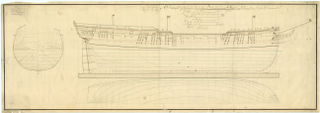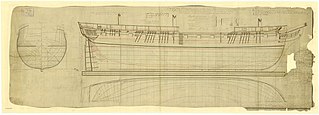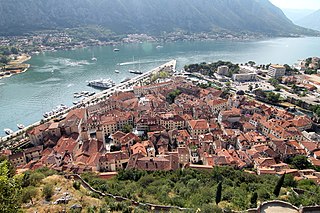HMS Saracen
The Royal Navy commissioned Saracen in August 1812 under Commander John Harper. All he had available to him were his marines and "a few worn-out sailors, retained for harbour duty". On 21 August Sir Richard Bickerton, commander-in-chief at Portsmouth, ordered Harper to patrol off the coast. The next evening Saracen was some 7 or 8 miles (11 or 13 km) off Beachy Head when Harper observed two large luggers chasing three well-laden British merchant vessels. After a short chase and some combat, Saracen succeeded in capturing the French privateer Coureur (or Courier), of Calais, by coming alongside and boarding her. Coureur was armed with 14 guns and had a crew of 50 men under the command of Captain Joreur. French casualties amounted to Joreur and two men wounded; Saracen had no casualties. Harper then returned with his prize to Portsmouth. He had too few men to man the prize, guard his prisoners, and still chase the second privateer. The prisoners reported that the second lugger was Honoria, of the same strength as Coureur. Coureur was a new vessel, and the two privateers were only eight hours out of Dieppe and had not captured anything when Saracen had appeared on the scene. [4]
Once Saracen had a full crew, Harper sailed her to the Mediterranean on 17 November. Initially Saracen convoyed merchant vessels sailing between Malta and the Archipelago. Harper was to operate from the Smyrna station, but he requested permission, which was granted, to sail to the Adriatic.
Saracen's first exploit occurred 17 June 1813. During a dark and stormy night, Harper took her boats and a landing party of some 40 seamen and marines to capture Zupano. This was one of three small islands on which the French had placed a garrison to protect vessels sailing into Ragusa. Harper and his men were able to capture 39 French soldiers, [5] though some 16 escaped. The British had to rely on bayonets in their attack as the rain had rendered their ammunition unserviceable. Still, in the 10 minute struggle they suffered only minor casualties. Harper dismissed and reorganized the national guard, dismissed the mayor, and appointed a local notable in his place.
After the loss of Zupano the French planned to reinforce their garrison on Mezzo, an island between Ragusa and Zupano. Harper and Captain Black, of Weazel, determined to forestall its reinforcement. On 17 July marines from both vessels landed and took possession of the town. The French retreated to a fortified castle on a hill, which the British then bombarded with a 12-pounder carronade they had brought from one of the ships. Harper had to leave for two days to go to Curzola. In his absence, Weazel's men established a battery of three brass guns on a point overlooking the castle. On 22 July, after his return, the British started firing on the castle. The French surrendered that afternoon. The British captured five 9-pounder guns, a brass howitzer, munitions, and 59 men. [5] The British freed their captives against their parole that they would not serve against the British until exchanged for an equal number of British prisoners. The capture of the island cost Saracen one man killed, and Weazle two men wounded.
Harper left the marines from Saracen and the brig Wizard, which had joined Saracen and put under Harper's orders, on Mezzo as a garrison. He also established a telegraph station on the island. After the loss of Zupano, the French general at Ragusa withdrew his men from Calamotta, the third of the Elaphiti Islands.
Harper and Saracen then extended the British blockade to Boca di Cattaro. Harper left a boat and eleven men to blockade Stagno and survey the coast. On 13 August a landing party from Saracen, Weazle, and Wizard landed at Boca di Cattaro and destroyed two batteries, one unfinished and the other armed with three 18-pounder guns that the landing party spiked and threw into the sea. The only two casualties were two men from Saracen, who were wounded.
Wizard and Weazle were needed elsewhere but Saracen remained, harassing the coast. Harper proceeded to use boats he had captured and Saracen's boats to make night raids along the coast. To augment his forces after dark Harper would take the marines he had on Mezzo, leaving only a lame man behind to give the impression of activity, and would then return them before dawn. One night in September, Harper received intelligence that the French were moving some 50 bullocks by road from Ragusa under a weak escort. He took 20 men, all that he had available, landed them, drove off the escort, gathered the bullocks, put them on some fishing boats, and brought them to Saracen.
On 12 October the frigate Bacchante, Captain Hoste, arrived off Ragusa. There three Sicilian gunboats and 50 soldiers joined him, as did Saracen. Harper took two of the gunboats, some boats from Saracen, and a combined force from Bacchante and Saracen and proceeded into the Boca. On the way he captured four gunboats, each armed with a 24-pounder gun (two also had an additional 12-pounder carronade in their sterns), after their local crews mutinied against the French. He then took his entire force, augmented by locals, and captured Fort St George. [lower-alpha 1] [lower-alpha 2]
On 16 October 1813, a party from Bacchante and Saracen, together with the Royal Corsican Rangers, captured Forts Epagnole and Castel Nuova. [9] The two forts mounted some 25 carriage guns and had a combined garrison of 299 men. [lower-alpha 3]
After the capture of the four gunboats Harper had sent them on to Cattaro to blockade it from the sea while local volunteers blockaded it from the land. On 20 October Saracen anchored near Cattaro to besiege it. Bacchante left for a time leaving Harper and Saracen to maintain the siege.
Between 20 and 23 October a party from Saracen, with the assistance of 300 Croatians, captured Stagno. There they captured 12 guns and 52 men. [5]
In November Harper proceeded to move an 18-poudner gun to the summit of Mount Theodore, overlooking Cattaro, finally succeeding on 23 December. Bacchante returned and the British were able to establish four batteries with which to bombard Fort St John at Cattaro. They commenced firing on Christmas Day. On 1 January 1814 two more batteries were brought into action. The British were preparing for an assault on 3 January when General Baron Gauthier, the French commander, offered to capitulate. The capitulation was signed on 5 January. In all, Bacchante and Saracen captured 130 guns and 900 men at Cattaro. [5]
On 28 January Bacchante, Saracen, and 400 Austrians captured Ragusa. There they captured 138 guns and 500 men. [5] The fall of Ragusa left the allies in command of Dalmatia, Croatia, Istria, Frioul, and all the islands in the Adriatic.
Saracen conveyed General Gauthier and his staff to Ancona. From there she sailed to Venice to join the blockade there. On 14 May Saracen sailed 12 miles (19 km) up the canal and anchored near St Mark's. Harper and Saracen now received orders to sail to America. Before she left Harper received the Order of Leopold sent by the Emperor of Austria. Harper received promotion to post captain on 7 June, only finding out when he arrived at Gibraltar. Harper returned from North America on 26 October.
Commander Alexander Dixie (acting) replaced Harper in June 1814. Between 21 October and 6 November, and 29 November and 19 December 1814, Saracen was in the Chesapeake with a squadron and so shared in the proceeds of several captures. During the first period the squadron captured the schooners Franklin and Saucy Jack. [lower-alpha 4] During the second period the squadron captured goods from the transports Lloyd and Abeona, and the schooner Mary. [lower-alpha 5]
On 30 October, Saracen was at Saint Mary's River, Maryland. A raiding party from Saracen landed at St Inogoes and proceeded to plunder the Jesuit mission, known as St. Inigoes Manor, including St. Ignatius Church, which was a part of the manor at the time. When the raiding party returned, Dixie sent one of his lieutenants under a flag of truce to return what had been taken and to convey a letter of apology to the priests and residents of the settlement there.
During the winter of 1814–1815, Saracen was still in the Chesapeake. One night, she slipped from her anchorage and destroyed 16 American vessels. She then sailed for the coast of France to participate in the effort to intercept Napoleon after his defeat at the battle of Waterloo. Saracen landed arms at Dieppe, where Dixie succeeded in establishing the White flag.
Dixie was still in command on 7 July 1815 at the capture of the French vessels Aimable Antoinette and Marie. Saracen, Harrier, Towey and Euryalus all shared in the prize money. [14] [lower-alpha 6] Admiralty records state that in August 1815 Commander John Gore assumed command at Bermuda. However, another source has Dixie paying her off on 9 September.
How Saracen got to Bermuda, when, and under whose command, is therefore unclear. Once Saracen arrived at Bermuda she then served either carrying dispatches across the Atlantic, or between Halifax and Bermuda. Saracen was paid off in 1817.










